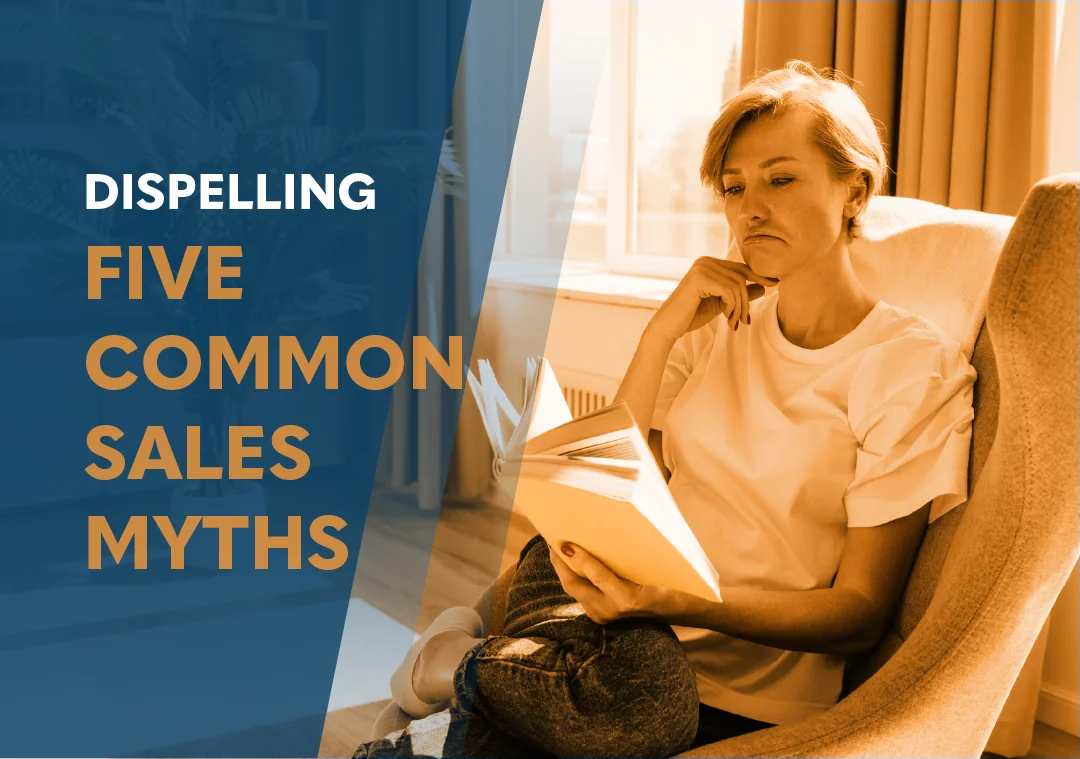Dispelling Five Common Sales Myths

Myths, misconceptions, and make-believe conceptions abound in the business world. Often, they lead aspiring sales professionals down the wrong path. Stephen Hawking, the renowned theoretical physicist, cosmologist, and author, said, “The greatest enemy of knowledge is not ignorance. It is the illusion of knowledge.”
This article will dissect the most common “illusions of knowledge” of selling. Understanding and dispelling common sales myths helps sellers perform better. Let’s explore why these common sales myths can hinder your sales success and what you should focus on instead.
Myth #1: The Best Salespeople are Natural Sellers.
A common misconception in sales is that top-performing salespeople are simply born for it. They naturally have the so-called “gift of gab.” While it’s true that some individuals may have certain innate qualities that lend themselves to sales, achieving true excellence in selling hinges on specific skills, knowledge, and training.
A salesperson’s natural disposition is not a hindrance. The common sales myth that only those “born for it” can be successful sellers is the real hindrance.
For example, consider Sarah, a sales professional who always had a knack for communication. While her outgoing nature gave her an edge, she understood that refining her skills and learning new strategies were essential for long-term success. She embraced humility and coachability, eagerly seeking opportunities for growth and improvement.
Dedication to continuous learning propelled her to become a high-performing salesperson.
Understanding that sales mastery is a journey of growth and development rather than an inborn trait is key to unlocking your full potential in this field. As a sales training company, we’ve worked with engineers, financial professionals, and I.T. reps who thought they could never sell because they lacked the “gift of gab.” We help them discover that this is a learnable skill.
Myth #2: Always Be Closing
The second biggest myth in sales is that salespeople should always be closing. While closing is undeniably a critical step in the sales process, it’s just one step in the buying journey. Equally crucial are the steps that come before and after closing. Building trust, stimulating interest, creating value with potential clients, and sustaining effective post-sale follow-up are equally pivotal for sustained sales success.
To illustrate, let’s consider John, a seasoned sales professional. He learned the key to enduring success in sales wasn’t solely reliant on closing deals. John invested time in understanding his clients’ needs, providing valuable insights, and genuinely connecting with them. Even after the sale, John continued to nurture these relationships, ensuring his clients were not only satisfied but also became enthusiastic advocates for his brand.
This approach paid off handsomely for John. His clients viewed him not as a product or service provider but as a trusted advisor in their business journey. This trust translated into repeat business and an ever-expanding network of satisfied customers who willingly recommended his services.
John’s success wasn’t solely rooted in his ability to close deals but in his skill in building and maintaining strong client relationships. This example stands as a reminder of the importance of the entire sales process, from initial contact to post-sale engagement, in achieving sustainable success in sales.
When sales professionals focus strictly on closing, they can expect to encounter several negative consequences, including:
- Short-Term Gains, Long-Term Losses: Prioritizing closing over building relationships can lead to short-term gains, but it often results in a lack of trust and repeat business in the long run.
- Poor Customer Experience: When the emphasis is solely on closing deals, customer needs and concerns may be overlooked. This can lead to dissatisfied clients being less likely to refer others or return for future business.
- Reputation Damage: Pushy or aggressive sales tactics can tarnish a company’s reputation. Negative word-of-mouth and online reviews can spread quickly, potentially harming the brand.
- High Churn Rates: When clients feel pressured into a purchase, they may later regret their decision and cancel or return the product or service, leading to high churn rates.
Myth #3: Lowest Price Always Wins
It’s widely believed that the lowest price wins in sales. However, this misconception could lead businesses down a perilous path. While price undoubtedly influences a purchasing decision, it’s just one component of the overall value proposition.
Competing strictly on price is not a viable option for most companies and sales professionals.
Renowned sales expert Zig Ziglar astutely noted, “Price is what you pay. Value is what you get.” This quote encapsulates a fundamental truth in sales: the true worth of a product or service extends far beyond its price tag. Customers seek solutions that fit their budget, provide measurable benefits, and address their specific needs.
For instance, consider a software company offering a premium subscription package at a higher price than its competitors. Instead of engaging in a price war, the company emphasizes the extensive features, simple user interface, upgraded security, top-rated customer support, and regular updates accompanying their product.
By clearly articulating how their offering meets the unique requirements of their prospects, they demonstrate superior value.
This strategic approach proved highly effective. Prospective clients recognized that the higher price point was justified by the exceptional value they would receive in return.
The company was not just selling a product. They were offering a comprehensive solution that would drive measurable results. Consequently, they attracted a clientele prioritizing quality and performance over price alone.
While pricing is undeniably a critical factor, it’s imperative not to underestimate the power of value. By focusing on how your product or service uniquely addresses the customer’s needs and provides them with a comprehensive solution, you position yourself as a provider of genuine worth, ultimately transcending the price point competition.
Myth #4: Discounts Win Clients
When salespeople rely on discounts, they often turn a big deal next month into a small one this month. Offering discounts or special deals might seem like an effective way to close, but it can decrease the likelihood of long-term sales success.
This common sales myth is harmful to the customer, the seller, and the product. Here are a few negative consequences of using discounting as a sales strategy:
- Perceived Devaluation of the Product or Service: Frequent discounts can create the perception that the product or service is not worth its original price, potentially eroding its perceived value in the customers’ eyes.
- Encouraging a Bargain-Hunting Mentality: Discount-focused selling can attract customers primarily looking for the cheapest option rather than those who value the product’s quality, features, or unique benefits.
- Setting Unreasonable Customer Expectations: Offering consistent discounts can lead customers to expect discounts as the norm. This can make it difficult to sell at full price in the future.
- Potential for Customer Disloyalty: Customers who are primarily driven by discounts may be less loyal and more likely to switch to a competitor offering a better deal.
Sales professionals should understand that selling on price and offering discounts are examples of taking the path of least resistance. Sales reps who use discounting as their default approach to winning business believe their product, service, and company is the exact equivalent of all competitors in the market. Rather than hyper-focus on delivering value and differentiating their solution, they rely on price reductions.
Failure to differentiate makes competing on price the only option. When sales professionals take the time to differentiate the unique benefits and advantages that set your offering apart, discounts are rarely needed.
Differentiating your service and aligning those services with what is strategically important to clients is key to maintaining margins and avoiding discounting.
Myth #5: Cold Outreach is Dead
There is a lot of debate on the value of cold outreach in modern selling. While the old-school mentality of picking up the phone and “smiling and dialing” a hundred strangers is no longer a best practice in modern selling, a structured cold outreach strategy can be highly effective.
The key lies in perfecting the timing of your outreach and delivering a personalized and compelling message that captures the prospect’s attention.
Here are some key strategies and considerations:
- Personalization is Key: Generic, one-size-fits-all messages are less effective in today’s sales landscape. Tailor your outreach to each recipient, showing that you’ve done your research and understand their specific needs or pain points.
- Value Proposition is Critical: Highlight the specific value your product or service can bring to the prospect’s business. Clearly communicate how it can address their challenges or improve their operations.
- Focus on Building Relationships: Instead of trying to make an immediate sale, aim to establish a meaningful connection with the prospect. This might involve offering insights, sharing relevant content, or engaging in discussions related to their industry or pain points.
- A/B Testing and Iteration: Experiment with different openings, voicemail messages, and outreach strategies. Analyze the results to see what works best. Be willing to adjust your approach accordingly.
- Metrics-Driven Approach: Track key metrics such as talk time, response, and conversion rates. Use this data to refine your outreach strategy and improve your overall effectiveness.
- Have a playbook: Having a prepared playbook on your ideal customer profile can help create a natural and engaging conversation flow.
Cold outreach is a highly underrated skill. There is not a single negative for a salesperson in improving their cold outreach skills. For modern sales professionals, cold outreach should be viewed as a valuable relationship-building tool. When cold outreach is performed strategically, it remains a valuable tool when executed with precision and personalization.
Conclusion
In sales, it’s easy to fall prey to myths and misconceptions that can lead aspiring professionals astray. I hope this article has debunked some of the most common myths in sales, shedding light on alternative perspectives that can drive success.
Success in sales isn’t about shortcuts or relying on old-school tactics. It’s about understanding the customer’s true needs, providing genuine value, and building lasting relationships.
By dispelling these myths, we pave the way for a more effective, sustainable, and ultimately fulfilling career in sales. Remember, knowledge is power, but it’s essential to ensure that this knowledge is grounded in truth, not illusion.

- Account Planning (11)
- Awards (50)
- Client Testimonial (37)
- Personal Branding (19)
- Podcast (11)
- Research (68)
- Sales Career Development (85)
- Sales Coaching (154)
- Sales Consulting (133)
- Sales Culture (164)
- Sales Enablement (340)
- Sales Leadership (108)
- Sales Management (242)
- Sales Negotiation (16)
- Sales Prospecting (124)
- Sales Role-Playing (18)
- Sales Training (229)
- Selling Strategies (255)
- Soft Skills (67)
- Talent Management (92)
- Trusted Advisor (27)
- Virtual Selling (41)
- Webinar (10)





























